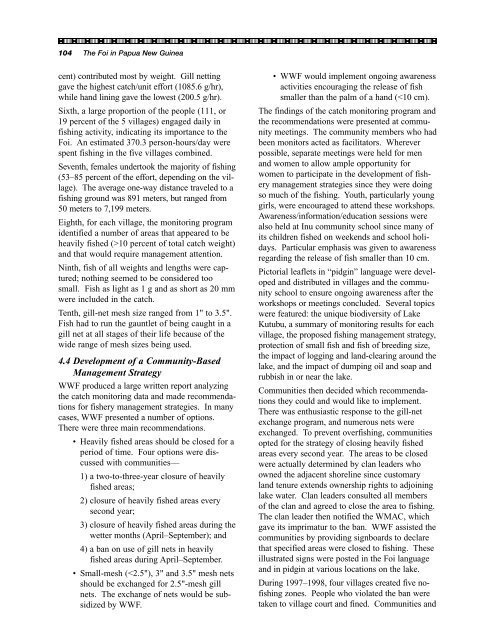Indigenous Peoples and Conservation Organizations
Indigenous Peoples and Conservation Organizations
Indigenous Peoples and Conservation Organizations
You also want an ePaper? Increase the reach of your titles
YUMPU automatically turns print PDFs into web optimized ePapers that Google loves.
104 The Foi in Papua New Guinea<br />
cent) contributed most by weight. Gill netting<br />
gave the highest catch/unit effort (1085.6 g/hr),<br />
while h<strong>and</strong> lining gave the lowest (200.5 g/hr).<br />
Sixth, a large proportion of the people (111, or<br />
19 percent of the 5 villages) engaged daily in<br />
fishing activity, indicating its importance to the<br />
Foi. An estimated 370.3 person-hours/day were<br />
spent fishing in the five villages combined.<br />
Seventh, females undertook the majority of fishing<br />
(53–85 percent of the effort, depending on the village).<br />
The average one-way distance traveled to a<br />
fishing ground was 891 meters, but ranged from<br />
50 meters to 7,199 meters.<br />
Eighth, for each village, the monitoring program<br />
identified a number of areas that appeared to be<br />
heavily fished (>10 percent of total catch weight)<br />
<strong>and</strong> that would require management attention.<br />
Ninth, fish of all weights <strong>and</strong> lengths were captured;<br />
nothing seemed to be considered too<br />
small. Fish as light as 1 g <strong>and</strong> as short as 20 mm<br />
were included in the catch.<br />
Tenth, gill-net mesh size ranged from 1" to 3.5".<br />
Fish had to run the gauntlet of being caught in a<br />
gill net at all stages of their life because of the<br />
wide range of mesh sizes being used.<br />
4.4 Development of a Community-Based<br />
Management Strategy<br />
WWF produced a large written report analyzing<br />
the catch monitoring data <strong>and</strong> made recommendations<br />
for fishery management strategies. In many<br />
cases, WWF presented a number of options.<br />
There were three main recommendations.<br />
• Heavily fished areas should be closed for a<br />
period of time. Four options were discussed<br />
with communities—<br />
1) a two-to-three-year closure of heavily<br />
fished areas;<br />
2) closure of heavily fished areas every<br />
second year;<br />
3) closure of heavily fished areas during the<br />
wetter months (April–September); <strong>and</strong><br />
4) a ban on use of gill nets in heavily<br />
fished areas during April–September.<br />
• Small-mesh (

















